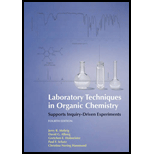
Interpretation:
The reason for the broader melting point range observed for second sample should be determined.
Concept introduction:
For a crystalline substance, the temperature at which the substance changes from solid phase to liquid phase is referred to as melting point. Melting point is directly associated with the presence of intermolecular forces like hydrogen bonding, dipole-dipole interactions. High molecular symmetry, large surface area, polarity is related to high melting temperature.
A pure compound melt at a narrow range and compounds with impurities have broad melting temperature. Melting points are obtained by filling the organic compound into the capillary tube with one end sealed.
Explanation of Solution
To determine the melting point of a sample the capillary tube is filled with a sample with one end sealed. After that, the sample is heated to a temperature where the solid sample begins to convert into a liquid phase which signifies its melting point.
If too much sample is added to the capillary, the range of melting point becomes broad as more time it takes to melt the whole sample while the temperature of the sample increases with time.
Therefore the sample height of
Want to see more full solutions like this?
Chapter 14 Solutions
Laboratory Techniques in Organic Chemistry
- explain how mixed melting point determination can be used to identify a solid compound.arrow_forwardWhy is fractional distillation more efficient than simple distillation when purifying liquid mixtures?arrow_forwardWhat are the differences between a simple distillation and steam distillation?arrow_forward
- Suppose you want to determine the eutectic melting point of a eutectic mixture of adipic acid (literature MP 153 degree C) and salicylic acid (literature MP 158 degree C) .What would you do and what would expect to observe? Be sure to include a very specific detailed plan that any inexperienced organic chemistry lab student could follow if they were to use your procedure.arrow_forwardDistinguish between Chemiluminescence and Triboluminescence and give an example of each.arrow_forwardIn the Dumas method for determining the molar mass of an unknown volatile liquid, a sample of a volatile liquid that boils below 100oC is vaporized in a boiling water bath and the mass of the vapor required to fill the flask is determined. The following data was collected: Flask Volume 100.0 + 100.0 + 79.6 mL = 279.6 mL Mass of Flask + Cap 143.85 g Mass of Flask + Condensed Liquid 144.95 g Mass of Condensed Liquid 1.10 g Temperature of Water Bath (oC) 84.1 oC Barometric Pressure (atm) 0.985 atm What is the molar mass of the unknown? What will its temperature be when the pressure is 1.20 atm and the volume is 250.0 mL?arrow_forward
- Consider the following scenario: a small amount of a solid got into a sample when preparing the capillary tube to determine its melting point. The student decided to take the melting point anyway. The student observes the following: (a) a sharp melting point (<2oC); (b) a melting point that closely matches the literature reported value. Which of the following conclusions will not be justified by the experimental results. The solid was a soluble impurity in the liquid phase. The solid was an insoluble impurity in the liquid phase. The solid was a sample of the same compound.arrow_forwardWhat is the function of a desiccant in a set-up of volatilization gravimetry? To remove nitrogen from the sample To remove sulfuric acid from the sample To remove water vapor from the sample To remove carbon dioxide from the samplearrow_forwardshort, 1-minute survey. DISMISS 5. In the Dumas method for determining the molar mass of an unknown volatile liquid, a sample of a volatile liquid that boils below 100°C is vaporized in a boiling water bath and the mass of the vapor required to fill the flask is determined. The following data was collected: 4oFlask Volume 100.0 + 100.0 + 79.6 mL = 279.6 mL Mass of Flask + Cap Mass of Flask + Condensed Liquid Mass of Condensed Liquid Temperature of Water Bath (°C) Barometric Pressure (atm) 143.85 g 144.95 g 1.10 g 84.1 °C 0.985 atm a. What is the molar mass of the unknown? b. What will its temperature be when the pressure is 1.20 atm and the volume is 250.0 mL?arrow_forward
- A student obtained a solid product in laboratory synthesis. To verify the identity of the solid, she measured the milting point and found that the material melted over a 12°C range. After it had cooled, she measured the melting point of the same sample again and found that this time the solid HUD a sharp melting point at the temperature that is characteristic of the desired product Why were the two melting points different? What was responsible for the change in the melting point?arrow_forwardUsing recrystallization techniques, a student attempts to purify 0.50 g of compound H. Based on the solubility of H in the chosen solvent at collection temperature, the maximum percent recovery is 82%. The student obtains 0.396 g of purified crystals. What is their percent recovery? Group of answer choices 41% 64% 79% 82% 97% none of thesearrow_forwardWhen a solution of 1.00 g of ‘X’ in 100 ml of water was shaken with 10 ml of diethyl ether, 0.60 g of X was transferred to the solvent (ether) layer. When another solution of 0.5 g of ‘X’ in 100 ml of water was shaken with 5 ml of petroleum ether, 0.3 g of X was extracted by the solvent. Which of these ethers is a better solvent? Justify your answer using calculations.arrow_forward
 Chemistry: The Molecular ScienceChemistryISBN:9781285199047Author:John W. Moore, Conrad L. StanitskiPublisher:Cengage Learning
Chemistry: The Molecular ScienceChemistryISBN:9781285199047Author:John W. Moore, Conrad L. StanitskiPublisher:Cengage Learning
